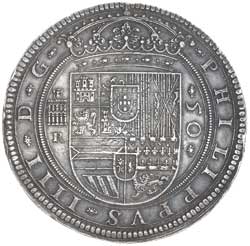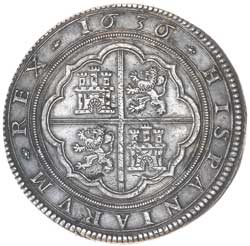World Silver & Bronze Coins (Philippines-Z)
Lot 3798 Session 12 (11.30am Thursday) World Silver & Bronze Coins (Philippines-Z)
Estimate $25,000
Bid at live.noble.com.au
SOLD $102,000
SPAIN, Philip IIII, silver fifty reales or cinquentina, 1636R, Segovia Mint, Assayer, Rafael Savan, obv. crowned Hapsburg shield, around PHILIPPVS IIII D G, rev. quartered arms of Castille and Leon in treasure, around HISPANIARVM REX (KM.149.5; Cayon 6591; Calico type 61, no 227). The usual minor planchet cracking and rim bruises, attractively gun metal grey toned good very fine and extremely rare, only about seven known.
This example, from an old estate of a World War I digger in Sydney in whose family it has remained for decades, has only come to light now and is on the market for the first time. Two similar examples of this extremely rare date were in the Spink Glendinings Sale, November 1974 (lot 861) and the John J.Pittman Collection (part 3) August 1999 (lot 4509, est $20,000 realised a record $143,750), in the same sale an Adelaide ingot realised $149,500 (lot 4921) and a Sydney Mint five pounds of 1887 realised $103,500 (lot 4936).
Philip IV inherited a country that held the most overseas territory of any in Europe, but was also the most disorganised of any European power. What Spain needed was to stay out of foreign wars and organize its vast holdings in a cohesive manner. What Spain did was to spend Philip's entire reign at war with the Netherlands, France, Portugal, the Protestant forces in the Holy Roman Empire, and England. These wars were justified by Spain's rulers as being God's will to establish Catholic orthodoxy but they essentially destroyed the Spanish fortunes that came from the New World and decimated the homeland populace. Among the many 'trophies' of the long and varied Spanish numismatic series are these massive 50 reales or 'cinquentines' (known in their time as 'monedas excelentes'), effectively the largest Spanish silver coins ever struck. They were made in very limited quantities throughout the 1600s. The concept appears to have been initiated (or at least encouraged) by the needs of rich Sevillan merchants who were presenting massive quantities of silver (presumably from Peru) to the mint all at once. To make such huge coins required the state-of-the-art technology of a hydraulic steam-press and special roller dies (cu¤os de rodillo), invented in Germany in the late 1500s and installed in a special mint in Segovia called the Real Ingenio. Very rare and special in their own time, these 50-reales coins are even more highly regarded today and can sell in the six-figure range. There are perhaps no finer emblems in silver from the Spanish Main than this magnificent, huge coin.
Estimate / sale price does not include buyer's premium (currently 22% including GST) which is added to hammer price. All bids are executed on the understanding that the Terms & Conditions of sale have been read and accepted. For information on grading and estimates please refer to the Buying at Auction advice.
Quick find
View a lot by number and sale.
Adjacent lots
Lot 3796
SOUTH AFRICA, twenty cents 1961, 1963, 1964 (KM.61) (3), ten cents 1963, 1964 (KM.60) (2); ...
Estimate $100
Lot 3797
SPAIN, Philip IV, cob, four reales, Seville 1620s (KM.35.6). Good very fine.
Estimate $140
Lot 3798 This lot
SPAIN, Philip IIII, silver fifty reales or cinquentina, 1636R, Segovia Mint, Assayer, Rafael Savan, obv. ...
Estimate $25,000
Lot 3799
SPAIN, Philip V, two reals, 1721J Seville Mint (KM.307); five pesetas, 1870 (70) SN-M, 1876 ...
Estimate $100
Lot 3800
SPAIN, Charles III, four reales, Madrid Mint, 1773PJ (KM.413.1). Attractive, very fine.
Estimate $150

